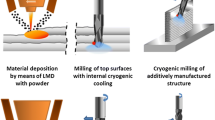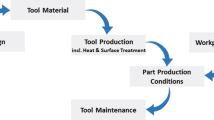Abstract
This paper concerns the wear of the working area of the permanent mould is strictly related to downfall in its functional properties. It may be caused by several different physical and chemical processes occurring during its exploitation and resulting mainly from the working conditions. The simplest wear factor is the material loss in the functional layer of the tooling, resulting mainly from the plastic strain, friction, corrosion or cracks of the surface layer. The tests were focused on comparative tests of inserts for high-pressure die-casting molds after their regeneration. Two methods were used for this process: TIG welding and laser surfacing. The scope of research included the study of surface microtopography and material structure on metallographic specimens. In particular, the thickness of the overlay layer, the heat affected zone were examined.
Access this chapter
Tax calculation will be finalised at checkout
Purchases are for personal use only
Similar content being viewed by others
References
Mathia, T.G., Pawlus, P., Wieczorowski M.: Recent trends in surface metrology. Wear 271, 494–508 (2011)
Jiang, X.J., Whitehouse, D.V.: Technological shifts in surface metrology. CIRP-Manuf. Technol. 61/1, 815–836 (2012)
Leach, R. (ed.): Characterization of a real surface texture. Springer, Berlin (2013)
Whitehouse, D.J.: Function maps and the role of surfaces. Int. J. Mach. Tools Manuf. 41, 1847–1861 (2001)
Novocic, D., Dewes, R.C., Aspinwall, D.K., Voice, W., Bowen, P.: The effect of machined topography and integrity on fatigue life. Int. J. Mach. Tools Manuf. 44, 125–134 (2004)
Stout, K.J., Blunt, L.: Three Dimensional Surface Topography. Penton Press, London (2000)
Kubiak, K.J., Liskiewicz, T.W., Mathia, T.G.: Surface morphology in engineering applications: influence of roughness on sliding and wear in dry fretting. Tribol. Int. 44, 1427–1432 (2011)
Sing, R., Melkote, S.N., Hashimoto, F.: Frictional response of precision finished surfaces in pure sliding. Wear 258, 1500–1509 (2005)
Tayebi, N., Polycarpou, A.A.: Modeling the effect of skewness and kurtosis on the static coefficient of rough surfaces. Tribol. Int. 37, 491–505 (2004)
Sedlacek, M., Podgornik, B., Vizitin, J.: Influence of surface preparation on roughness parameters, friction and wear. Wear 266, 482–487 (2009)
Lopatková, M., Bárta, J., Marônek, M., Šugra, F., Kritikos, M., Samardžić, I., Marić, D.: The influence of surface roughness on laser beam welding of aluminium alloys. Technical Gaz. 28(3), 934–938 (2021). https://doi.org/10.17559/TV-20201102100726
Wang, T., Li, Y., Liu, J., Qin, L., Wang, N., Zhang, L., Wang, H., Li, Z.: Milling force and surface topography of Ti-6Al-4V titanium alloy cladded by the laser. Surf. Rev. Lett. 26(8), 1850185 (1–11) (2018). https://doi.org/10.1142/S0218625X18501858
Acknowledgment
The research was financed under the project Actions 1.2 "Strengthening the innovation potential of Wielkopolska enterprises" of the Wielkopolska Regional Operational Program for 2014–2020 project no. RPWP.01.02.00–30-0080/17: Development of R&D in the GTS enterprise Grzegorz Stawiński as a chance for implementation innovation.
Author information
Authors and Affiliations
Corresponding author
Editor information
Editors and Affiliations
Rights and permissions
Copyright information
© 2023 The Author(s), under exclusive license to Springer Nature Switzerland AG
About this paper
Cite this paper
Matysiak, W. et al. (2023). Regeneration of Mould Inserts Using the Laser Welding Method. In: Blažević, D., Ademović, N., Barić, T., Cumin, J., Desnica, E. (eds) 31st International Conference on Organization and Technology of Maintenance (OTO 2022). OTO 2022. Lecture Notes in Networks and Systems, vol 592. Springer, Cham. https://doi.org/10.1007/978-3-031-21429-5_14
Download citation
DOI: https://doi.org/10.1007/978-3-031-21429-5_14
Published:
Publisher Name: Springer, Cham
Print ISBN: 978-3-031-21428-8
Online ISBN: 978-3-031-21429-5
eBook Packages: EngineeringEngineering (R0)




